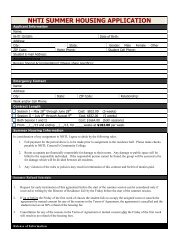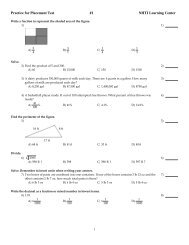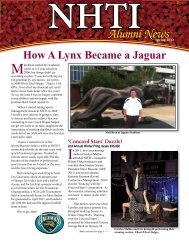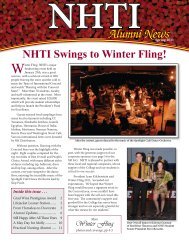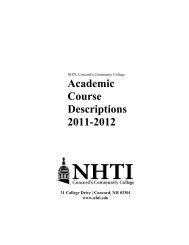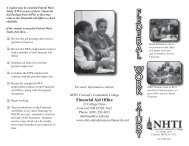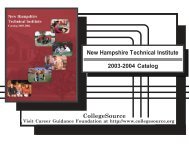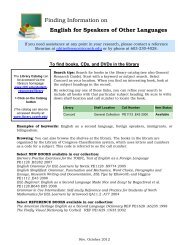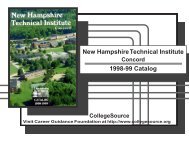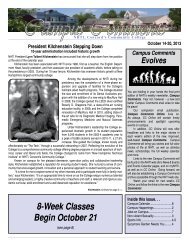Catalog 05-06 - NHTI - Concord's Community College
Catalog 05-06 - NHTI - Concord's Community College
Catalog 05-06 - NHTI - Concord's Community College
- No tags were found...
Create successful ePaper yourself
Turn your PDF publications into a flip-book with our unique Google optimized e-Paper software.
Copyright & Disclaimer Information: Copyright © 1994, 1995, 1996, 1997, 1998, 1999, 2000, 2001, 2002, 2003, 2004, 20<strong>05</strong>, 20<strong>06</strong>, 2007. <strong>College</strong>Source®, Inc. and Career Guidance Foundation. <strong>College</strong>Source® digital catalogs are derivative works owned and copyrighted by <strong>College</strong>Source®, Inc. and Career Guidance Foundation. <strong>Catalog</strong> content is owned and copyrighted by the appropriate school. While <strong>College</strong>Source®, Inc. and Career Guidance Foundation provides information as a service to the public, copyright is retained on all digital catalogs.Copyright & Disclaimer Information: Copyright © 1994, 1995, 1996, 1997, 1998, 1999, 2000, 2001, 2002, 2003, 2004, 20<strong>05</strong>, 20<strong>06</strong>, 2007. <strong>College</strong>Source®, Inc. and Career Guidance Foundation. <strong>College</strong>Source® digital catalogs are derivative works owned and copyrighted by <strong>College</strong>Source®, Inc. and Career Guidance Foundation. <strong>Catalog</strong> content is owned and copyrighted by the appropriate school. While <strong>College</strong>Source®, Inc. and Career Guidance Foundation provides information as a service to the public, copyright is retained on all digital catalogs.Course Descriptionstice the fundamental skills of screening, intake, orientation, assessment,treatment planning, counseling, case management, crisis intervention,client education, referral, record keeping and consultation. (Prerequisites:AD 120, AD 2<strong>05</strong>, HU 111, MH 185, PY 1<strong>05</strong>, PY 220 and PY 283,with a combined major field GPA of 2.0)AD 295 Internship II: Orientation to AddictiveBehaviors Counseling* 2-12-6The second internship experience offers 30 hours of classroom-basedgroup clinical in support of 180 hours of field work in an approvedclinical setting. The student assumes increased responsibility culminatingin substantial use of the fundamental skills of screening, intake, orientation,assessment, treatment planning, counseling, case management, crisisintervention, client education, referral, record keeping and consultationin direct contact with clients/patients. A greater understanding of availabletreatment resources is accomplished via an inspection of the statewidecontinuum-of-care. (Prerequisite: AD 294)AD 296 Addiction Practicum I* 2-8-4The first internship experience offers 30 hours of classroom-based groupclinical supervision in support of 125 hours of fieldwork in an approvedclinical setting. The student initially learns to integrate into an agencyatmosphere within which they may research, observe, role-play and practicethe fundamental skills of screening, intake, orientation, assessment,treatment planning, counseling, case management, crisis intervention,client education, referral, record keeping and consultation. (Prerequisites:AD 120, AD 2<strong>05</strong>, HU 111, MH 187, PY 1<strong>05</strong> and PY 283, with acombined major field GPA of 2.0; PY 220 may be taken as a pre-orcorequisite)AD 297 Addiction Practicum II* 2-8-4The second internship experience offers 30 hours of classroom-basedgroup clinical supervision in support of 125 hours of fieldwork in anapproved clinical setting. The student assumes increased responsibilityculminating in substantial use of the fundamental skills of screening,intake, orientation, assessment, treatment planning, counseling, case management,crisis intervention, client education, referral, record keepingand consultation in direct contact with clients/patients. A greater understandingof available treatment resources is accomplished via an inspectionof the state-wide continuum-of-care. (Prerequisite: AD 296)* The student will also complete an interview with the practicum coordinator thesemester prior to the first scheduled practicum. Special requests regarding practicumentrance may be brought to the department head by the student. Review of therequests will be made by the department faculty and special exemptions may be madefor entrance into the practicum.AnthropologyAN 101 Introduction to Cultural Anthropology 3-0-3This course is an introduction to the perspectives, methods, and ideas ofcultural anthropology and will analyze human diversity and similaritiesamong people throughout the world, both western and non-western,through cross-cultural comparison. Topics include: culture and society;ethnographic research; ethnocentrism and cultural relativism; how societiesadapt to their environment; different forms of marriage and socialrelationships; male, female and other forms of gender; the social functionsof religion; and the processes of social-cultural change.AN 110 Introduction to Archaeology 3-0-3This introductory course examines the scientific tools and sophisticatedresearch that are currently changing our ideas about ancient civilizations.In the last 40 years, archaeologists have discovered many keys that dramaticallyunlock mysteries out of the past. Students will understand howarchaeology and anthropology interact, with emphasis on how peoplebehaved in the past, with reconstruction of basic social, political andeconomic institutions of their culture.AN 210 Native American Studies I 3-0-3A study of North American Indian cultures from the lithic period to the21 st century. Origin of Native American civilization and developmentwill be studied, including: lifeways, religion, ceremonies, arts and socialorganizations. The course will first focus on Mesoamerica during the pre-Columbian period. The study then proceeds to an in-depth review of thepeople/tribes of the Northeastern and southeastern woodlands and theGreat Plains cultural area.Architectural Engineering TechnologyAR 101 AutoCAD 2D 3-0-3This is an introductory course in Computer-Aided Drafting (CAD) forbeginning students. Topics include drawing set-up, line drawing, textplacement, orthographic drawing, basic editing, and dimensions. Thishands-on course, using AutoCAD 2002, focuses on the most commonbasic functions necessary to complete 2-D drawings including move,mirror, copy, offset, trace, OSNAP, distance, and more. Projects incorporatebasic techniques of drawing and computer-aided drafting. This courseis part of the CAD Certificate program. Note: Students are expected to be able toread and interpret architectural/engineering graphics to register for this course.AR 102 AutoCAD 3D 3-0-3This course introduces students to architectural three-dimensional CADapplications, 3-D manipulation of entities and to create and controlviews in 3-D space through Isometric and perspective projections. Topicsinclude three-dimensional drawing, coordinate systems, viewing, rendering,modeling, and output options. Upon completion, students should beable to prepare basic architectural three-dimensional drawings and renderings.This course is part of the CAD certificate program. (Prerequisite: AR101 or permission of department head of Architectural EngineeringTechnology)AR 103 Architectural Graphics and Sketching 2-2-3The first semester is devoted to the basic ways of representing architecturalideas graphically through the development of sketching and computer-aided-drawing(CADD) skills. Architectural line techniques, letteringstyles, geometric construction, principles of projection and drawingexpression are the areas of early concentration. Architectural design issuesare studied regarding residential planning and siting. The studentproduces floor plans, foundation plans, site plans, elevations, buildingsections, wall sections and details. An introductory structural analysis forfoundation loading is explored. Production of drawings by sketching andCAD demonstrates the student's ability to perform. (Corequisite: AR120) Note: CAD certificate students taking this course will not be required toregister for AR 120.AR 104 Architectural Design Studio I 2-2-3The student will study the architectural design for an institutional buildingthat is designated for public use. The terrain is sloping and provides fora two-story sloped roof structure that employs current construction methods.The student begins study through the use of sketch-to-scale drawings.With an outline of design criteria and project guidelines, the studentdevelops preliminary presentation drawings for floor plans, elevationsand 3-dimensional views. As the student comes to know and appreciatethe design, the emphasis shifts to a more in-depth understanding of thetechnology of construction. The student prepares construction documentsfor floor plans, elevations, building sections, wall sections anddetails. The preparation of preliminary drawings and construction documentsinclude sketching to scale and CADD using AutoCAD ArchitecturalDesktop software. The student demonstrates competency by studying,discussing and producing these drawings and presenting them to theclass as a way of working on relevant verbal skills. (Prerequisites: AR 103and AR 120)AR 120 Materials and Methods of Construction 4-0-4A survey of the materials used in building construction, the methods usedin assembling these materials into structures, and the forces acting on86



